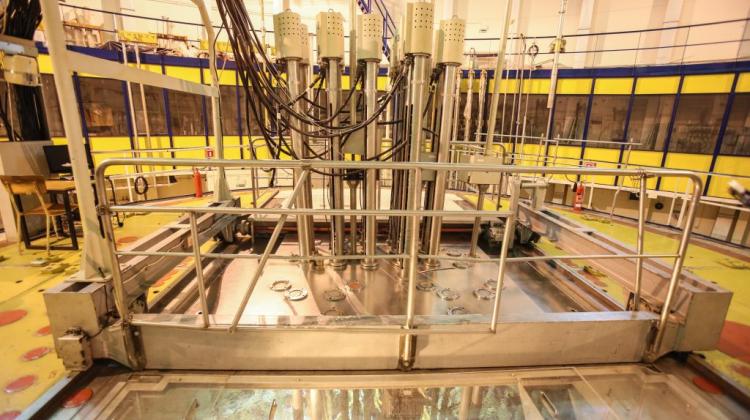The MARIA reactor is preparing for research on boron neutron capture therapy

Changes are coming in the MARIA reactor in Świerk. A new research station will be built. Accelerated neutrons from the reactor will help researchers and the medical community master the boron neutron capture therapy, which is already used in cancer treatment abroad.
Boron Neutron Capture Therapy (BNCT) is the hope of treating cancers that are difficult to treat surgically - disseminated or inaccessible to the scalpel - especially brain, head and neck, but also liver cancers.
Pharmaceuticals containing boron are delivered to the patient\'s body, primarily to tumour cells where they are accumulated. The patient\'s body is irradiated with a stream of accelerated neutrons. The energy of these neutrons is so high that when they penetrate the tissues, they actually destroy only the boron-containing cells that they encounter. The boron atoms react with neutrons and disintegrate, killing the cell in which they are located and possibly a few of its neighbours. "Some call it cellular surgery" - told PAP Dr. Michał Gryziński, Head of Mixed Radiation Dosimetry Lab at the National Centre for Nuclear Research (NCBJ) in Świerk.
He added that until now, this therapy was not very popular in the world because treatment was difficult to organize. Neutrons with the right energy and in the amount needed for BNCT could only be produced in nuclear research reactors. Transporting patients to a reactor station is not a convenient solution, so medical teams were not open to taking advantage of this treatment.
Gryziński revealed, however, that the impasse associated with this type of therapy would soon be broken. It is no secret two Japanese companies will soon launch the first neutron generators for BNCT, which can be installed in hospitals. Prototype machines already operate in several locations in Japan.
The National Centre for Nuclear Research wants the Polish researchers and the medical community to be prepared for this upcoming renaissance of BNCT. Later this year, a new station will be launched in Świerk to study the phenomena associated with this therapy. And there are only a few such research stations - not only in Europe but in the world.
The researcher emphasised that clinical trials will not be conducted in MARIA and patients will not be treated there. It will be a research station.
Gryziński hopes that in MARIA it will be possible to study new, more efficient boron carriers that will deliver this element to tumour cells and prevent it from leaving the cell.
"At this point, for every three cells destroyed during therapy, we lose one healthy cell" - said Dr. Gryziński and added that it is worthwhile to work on solutions that will further reduce damage to healthy cells during therapy. Pre-clinical research on this topic will also be conducted.
But before BNCT research can begin, MARIA will need to be prepared. According to Gryziński, a converter with 24 small uranium plates with a total power of 10 kW will appear in the reactor pool. That\'s where the neutrons will be emitted from. During the test, a beam of neutrons will pass through the appropriate channel in the pool and reactor wall. Researchers at the test station will check the performance of neutrons with energies ranging from several thousand to one million electron volts.
Gryziński noted that neutrons become dangerous for body cells only after they lose energy. The station will allow to precisely regulate the energy of the neutrons that will pass through the test object. After that, these dangerous neutrons will be caught to ensure that the work at the station is safe.
The concrete wall of the reactor is already equipped with a channel through which neutrons could pass during experiments, but now a new locking and shielding system through which neutrons will pass is being prepared. The uranium plate converter and the intermediate channel in the pool will also be new. (The NCBJ is still awaiting permissions to install this channel in MARIA). "The new station will be launched later this year - we hope that the first neutrons the reactor will leave in September" - said Michał Gryziński.
"The new station will allow to conduct not only BNCT research, but also materials research" - added the researcher. He gave the example that the new neutron beam will allow to study electronic devices that are sent into space. They must be resistant to radiation. It will also be possible to conduct research on the devices installed, for example, on transcontinental airplanes.
On Monday 15 May one of the most important conferences on neutron issues, organized by the Institute of Nuclear Physics PAS and EURADOS, starts in Kraków. One of the NEUDOS-13 thematic sessions concerns BNCT. On 22 May, the Medical University of Białystok will host a meeting of the International Scientific Network Neobor and BNCT workshops with the participation of representatives of the major BNCT research and therapeutic centres from Japan, Finland, Russia, Italy and Argentina.
PAP - Science and Scholarship in Poland, Ludwika Tomala
lt/ agt/ kap/
tr. RL
Przed dodaniem komentarza prosimy o zapoznanie z Regulaminem forum serwisu Nauka w Polsce.














